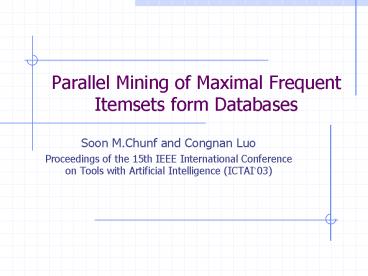Parallel Mining of Maximal Frequent Itemsets form Databases - PowerPoint PPT Presentation
1 / 12
Title:
Parallel Mining of Maximal Frequent Itemsets form Databases
Description:
In mining association rules, the most time-consuming job is finding all frequent ... Drawback: quire synchronization between nodes to exchange the count information ... – PowerPoint PPT presentation
Number of Views:141
Avg rating:3.0/5.0
Title: Parallel Mining of Maximal Frequent Itemsets form Databases
1
Parallel Mining of Maximal Frequent Itemsets form
Databases
- Soon M.Chunf and Congnan Luo
- Proceedings of the 15th IEEE International
Conference on Tools with Artificial Intelligence
(ICTAI03)
2
Outline
- Introduction
- Max-Miner Algorithm
- Parallel Max-Miner (PMM) Algorithm
- Performance Evaluation
- Conclusion
3
Introduction (1)
- In mining association rules, the most
time-consuming job is finding all frequent
itemsets from a large database with respect to a
given minimum support - In Apriori, the subset-infrequency based pruning
step prevents many candidate k-itemsets from
being counted in each pass k - In Apriori-like algorithms, if there is a
frequent itemset with length l, then they will
generate and count its 2l subsets.
4
Introduction (2)
- Our basic idea is that if we find a large
frequent itemset early, we can avoid counting all
its subsets because they are all frequent - We propose a parallel algorithm, named Parallel
Max-Miner (PMM), for mining maximal frequent
items - The PMM requires multiple passes over the
database, like the Count Distribution algorithm,
need synchronization between nodes at every pass
end
5
Max-Miner algorithm
- Unlike Apriori, the Max-Miner algorithm extracts
only the maximal frequent itemset - Superset-frequency based pruning
- Max-miner always attempts to look ahead in order
to identify large frequent itemsets early - So all subsets of these discovered frequent
itemsets can be pruned form the search space
6
Set-enumeration tree of Max-Miner (1)
7
Set-enumeration tree of Max-Miner (2)
- Each node in the tree is called a candidate group
- A candidate group g consists of two components
which are actually two itemsets - The first itemset is called the head of the group
and denoted by h(g) - The second itemset is called the tail of the
group and denoted by t(g) - t(g) is an ordered set and contains all the items
not in h(g) but can potentially appear in any
subnode derived from node g
8
The main procedure of Max-Miner (1)
- From the root of the tree at level 0, count the
support of 1-itemsets. - Only the 1-itemsets which are frequent can be
enumerated at level 1 - 4 nodes are generated at level 1 if 1, 2, 3, and
4 are all frequent 1-itemsets - For the node g1, we need to count the support of
h(g1) t(g1)1,2,3,4 - If the support of h(g1) t(g1) is equal or
greater than minsup, then we do not need to
expand the tree from the node g1 anymore
9
The main procedure of Max-Miner (2)
- At any node g, if h(g) t(g) is not frequent,
for each item I in t(g), we check if h(g) i
is frequent - If h(g) i is frequent, a corresponding
subnode is generated - We notice that for a candidate group node g, if
an item appears last in the tail of g in
ordering, it will appear in most offsprings of
the node g - To discover the maximal frequent itemsets early,
we better order the subnodes of each node in
ascending order of their support
10
Parallel Max-Miner (PMM) algorithm
- The database is evenly divided into N partitions
D0, D1, D2, , DN-1, one for each of the N
nodes P0, P1, P2, , PN-1 - Each node has the same number of transactions
allocated - PMM requires multiple passes over database
- For each pass k, all the nodes have exactly the
same set of candidate groups, Ck. - Each node count the support of Ck in local
database, independently - At the end of each pass, all nodes exchange the
count information so that they can generate the
same set of Ck-1 for the next pass
11
Performance Evaluation
Speedup of PMM
Sizeup of PMM
12
Conclusion
- We proposed a parallel maximal frequent itemset
mining algorithm, Parallel Max-Miner, for
shared-nothing multiprocessor systems - Drawback quire synchronization between nodes to
exchange the count information at the end of
every pass































